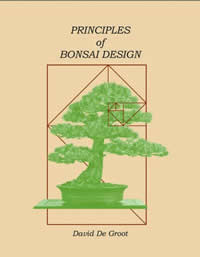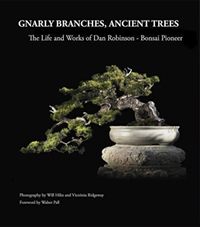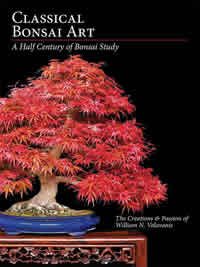Recent Bonsai Books Offer Local and Broader Perspectives
These books profile, or are written by, three of the best-known artists in the American bonsai community. Two of the artists are based in the Puget Sound region.
 David De Groot was the curator of the Pacific Rim Bonsai Collection (now the Pacific Bonsai Museum) in Federal Way for 25 years, until his retirement in 2014. His book Principles of Bonsai Design is the long-awaited new and expanded version of his 1995 classic Basic Bonsai Design. In his new book the author enlarges on his view that bonsai should be considered as a fine art rather than a horticultural novelty. Interestingly, he was a classical musician before becoming a bonsai practitioner, and is a collector of Asian art. There is little information here about how to train trees as bonsais or how to care for them. The emphasis is on choosing a design that references nature, but is a work of art in its own right. The book has many very clear drawings illustrating his points about proportion, balance, container selection and display options. Photographs show examples of trees in nature that can act as inspirations for bonsai design. This is not the book to page through for awe-inspiring pictures of bonsai, but rather to use as a reference when deciding how to convert starting plant material into an aesthetically-pleasing bonsai.
David De Groot was the curator of the Pacific Rim Bonsai Collection (now the Pacific Bonsai Museum) in Federal Way for 25 years, until his retirement in 2014. His book Principles of Bonsai Design is the long-awaited new and expanded version of his 1995 classic Basic Bonsai Design. In his new book the author enlarges on his view that bonsai should be considered as a fine art rather than a horticultural novelty. Interestingly, he was a classical musician before becoming a bonsai practitioner, and is a collector of Asian art. There is little information here about how to train trees as bonsais or how to care for them. The emphasis is on choosing a design that references nature, but is a work of art in its own right. The book has many very clear drawings illustrating his points about proportion, balance, container selection and display options. Photographs show examples of trees in nature that can act as inspirations for bonsai design. This is not the book to page through for awe-inspiring pictures of bonsai, but rather to use as a reference when deciding how to convert starting plant material into an aesthetically-pleasing bonsai.
 The second book, Gnarly Branches, Ancient Trees profiles the life and work of Dan Robinson, written by a friend and fellow bonsai enthusiast, Will Hiltz, with additional photography by Victrinia Ridgeway. Dan Robinson is the owner of Elandan Gardens near Bremerton and is known to many local residents through his display gardens at the Seattle Flower and Garden Show. He trained in forestry and worked for many years as a landscaper. This work, and his posting to Korea while serving in the army in the 1960’s, inspired an interest in bonsai. His bonsai creations are highly original—naturalistic and free-form, in contrast to the refined style of traditional Japanese bonsai. Many originated with trees collected locally from sites where they were surviving under stress, such as in bogs or on rocky mountain peaks. The appeal of this book is not just the story of a local personality in the bonsai community, but also the beautiful photography of the bonsais he has created.
The second book, Gnarly Branches, Ancient Trees profiles the life and work of Dan Robinson, written by a friend and fellow bonsai enthusiast, Will Hiltz, with additional photography by Victrinia Ridgeway. Dan Robinson is the owner of Elandan Gardens near Bremerton and is known to many local residents through his display gardens at the Seattle Flower and Garden Show. He trained in forestry and worked for many years as a landscaper. This work, and his posting to Korea while serving in the army in the 1960’s, inspired an interest in bonsai. His bonsai creations are highly original—naturalistic and free-form, in contrast to the refined style of traditional Japanese bonsai. Many originated with trees collected locally from sites where they were surviving under stress, such as in bogs or on rocky mountain peaks. The appeal of this book is not just the story of a local personality in the bonsai community, but also the beautiful photography of the bonsais he has created.
 Finally, Classical Bonsai Art by William N. Valavanis is both an introduction to the basic techniques and design of bonsai, and also a detailed description of the development of 100 of his bonsai creations over several years. The author is the founder of the International Bonsai Arboretum in Rochester, New York, the organizer of several U.S. National Bonsai Exhibitions and a nationally known bonsai teacher. He relates that his interest in bonsai began when he was 11 years old, and continued through his undergraduate studies in ornamental horticulture. He subsequently made many trips to Japan and apprenticed with famous bonsai masters there. The most fascinating aspect of the book is the insight it gives into the way the author plans a design from his starting material and then manipulates the tree to achieve his goal. He documents the process with detailed photographs often spanning periods of up to 30 years. Along the way we see how he tried out various containers or different orientations of the tree. Each sequence ends with a beautifully-staged photograph of the bonsai in its current state.
Finally, Classical Bonsai Art by William N. Valavanis is both an introduction to the basic techniques and design of bonsai, and also a detailed description of the development of 100 of his bonsai creations over several years. The author is the founder of the International Bonsai Arboretum in Rochester, New York, the organizer of several U.S. National Bonsai Exhibitions and a nationally known bonsai teacher. He relates that his interest in bonsai began when he was 11 years old, and continued through his undergraduate studies in ornamental horticulture. He subsequently made many trips to Japan and apprenticed with famous bonsai masters there. The most fascinating aspect of the book is the insight it gives into the way the author plans a design from his starting material and then manipulates the tree to achieve his goal. He documents the process with detailed photographs often spanning periods of up to 30 years. Along the way we see how he tried out various containers or different orientations of the tree. Each sequence ends with a beautifully-staged photograph of the bonsai in its current state.